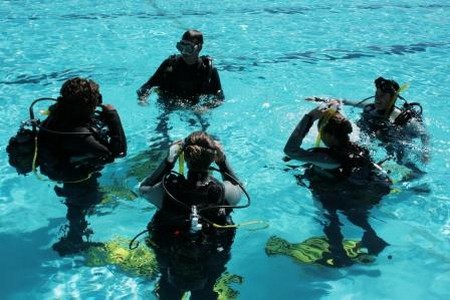In the early days of scuba diving, people practised sharing one regulator between two people. This was easy to perform in the pool but was probably responsible for a lot of accidents in the sea.
The octopus rig
Someone then realised it made sense to fit an alternate second-stage to the regulator, called the octopus rig.
Every diver should be equipped with an alternate air source for use by another diver. Training agencies have different suggestions on how to do this. Some suggest you rig your octopus to the right so that it is on the same side as your primary regulator. However, this can prove awkward for another diver to breathe from. Other agencies tell you to rig it on the opposite side so that another diver can access it more easily. Some agencies suggest that a diver should have the secondary regulator on a long hose so that it is good for sharing. This means stowing it under an elastic strap at the side of the tank. Other agencies insist that the primary regulator is on a long hose looped under the arm and over the shoulder so that another diver can take it in an emergency. The secondary regulator is rigged on a necklace for the first diver to use.
Yet another way is to have an alternate second-stage combined with the direct-feed to the BC. This can only be used by the wearer of the BC, so the primary regulator must be given to the other diver.
Whatever way you rig your alternate air urce, it should be clearly visible so your buddy can find it easily.
Why share?
Diving equipment is simple and reliable and rarely fails underwater. The main reason that someone may need to share the air of another diver is because they mismanaged their air supply. Consequently, the only time you are likely to need to share is in the shallows when it may be necessary to do an unplanned decompression stop. Otherwise, it makes more sense to swim up to the surface.
It is important to start a dive with an air supply that is sufficient to complete a dive as planned. This means having a good idea of what your air requirements are. On the dive, you should look at your pressure gauge and manage the supply. With a 50-bar reserve, it should never be necessary to share air. If you manage your own supply too finely, you could have problems should another diver, who is probably distressed and breathing heavily, wants to use some of the air that remains in your tank.
In the unlikely event that someone will need air, get them breathing from your alternate air source by offering it to them with the purge slightly depressed so that it is bubbling and will not need clearing. They may not be capable of blowing into it to clear the mouthpiece. Or they may not know where the purge button is. Start heading towards the surface immediately at a safe ascent rate. You can blow orally into a BC corrugated hose to provide buoyant support at the surface if needed.
